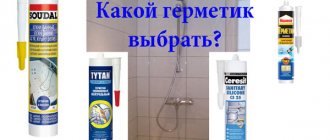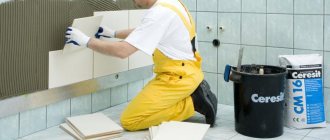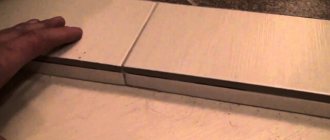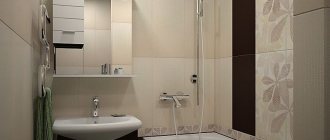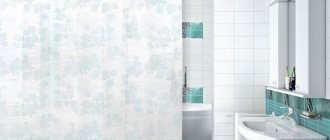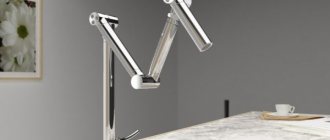Updated: 09.19.2019 11:10:34
*Review of the best according to the editors of expertology.ru. About the selection criteria. This material is subjective in nature, does not constitute advertising and does not serve as a purchase guide. Before purchasing, consultation with a specialist is required.
When performing finishing work in the bathroom, you cannot do without a material such as sealant. Using this product, seams between tiles are sealed, joints between plumbing fixtures and walls are insulated, decorative skirting boards are attached, etc. The need to fill voids with sealant is explained not only by aesthetics, but also by the need to protect the surface from moisture and microorganisms. Today there is a large assortment of specialized formulations on sale from different manufacturers. When choosing the best bathtub sealant, there are a few important things to consider.
Silicone
Quite a popular type of sealing compounds. The composition can be acidic or neutral. Acid ones are easier to produce and cost less, but working with them indoors is difficult - there is a strong smell until they harden. The second negative point of acidic ones is that when applied to metal, it quickly oxidizes. Therefore, it should not be used to seal steel and cast iron bathtubs. Neutral silicone sealants do not react with materials, so their scope of application is wider. But the production technology is more complex and they cost more.
Silicone sealant for the bathroom is a good solution
Both acidic and neutral silicone sealants may or may not be waterproof. Only waterproof ones are suitable for baths. They also come in one-component and two-component types. For private use, single-component ones are mainly used, since they do not need to be mixed before use.
Properties and scope
Properties and scope of application of silicone sealants:
- They have good adhesive ability. They can be used to seal joints between stone and plastic window sills, when installing sinks and other appliances into the countertop.
- It is used for sealing joints of glass, non-porous building materials (metal, plastic, glass, wood, ceramics), joining plasterboard to the ceiling, and drainpipes.
Silicone bathroom sealant is a good choice
- They are characterized by increased tolerance to high temperatures and can be used to seal seams around chimneys.
- They are resistant to water and can be used to seal junctions of bathtubs and showers, sinks and other plumbing fixtures.
The main advantage of silicone sealants is that after polymerization the seam remains quite elastic. It does not crack and can be used to seal the joint between an acrylic or steel bathtub and a wall. Disadvantage: susceptibility to the appearance and proliferation of fungus. It can be solved by adding antiseptic additives. To prevent the development of mold and mildew, it is better to use silicone sealant for an aquarium or a special plumbing sealant. Both of these types have antibacterial properties.
Brands and prices
Silicone bathtub sealants are popular today and any store will have a fairly decent assortment.
| Name | Color | Special properties | Surface film formation | Release form and volume | Price |
| BAU MASTER UNIVERSAL | white | acid | 15-25 minutes | Gun tube (290 ml) | 105 RUR |
| Bison Silicone universal | white, colorless | acidic, resistant even to sea water | 15 minutes | Gun tube (290 ml) | 205 RUR |
| KIM TEC Silicon 101E | white, transparent, black, gray | acidic, contains antibacterial additives | 25 min | Gun tube (310 ml) | 130-160 rub. |
| Somafix universal silicone | white, colorless, black, brown, metallic | acid | 25 min | Gun tube (310 ml) | 110-130 rub. |
| Somafix construction | white, colorless | neutral, does not turn yellow | 25 min | Gun tube (310 ml) | 180 rub. |
| Soudal Silicone U universal | white, colorless, brown, black, | neutral | 7 min | Tube for pistol (300 ml) | 175 RUR |
| WORKMAN Silicone Universal | colorless | acid | 15 minutes | Tube for pistol (300 ml) | 250 rub. |
| RAVAK Professional | neutral, antifungal | 25 min | Gun tube (310 ml) | 635 RUR | |
| Ottoseal s100 sanitary | 16 colors | acid | 25 min | Gun tube (310 ml) | 530 rub. |
| Lugato Wie Gummi Bad-Silicon | 16 colors | neutral with bactericidal additives | 15 minutes | Gun tube (310 ml) | 650 rub. |
| Tytan silicone sanitary, UPG, Euro-Line | colorless, white | acidic with bactericidal additives | 15-25 minutes | Gun tube (310 ml) | 150-250 rub. |
| Ceresit CS | colorless, white | acidic/neutral | 15-35 min | Gun tube (310 ml) | 150-190 rub. |
As you can see, there is a very wide range in prices. Expensive sealants (Ravak, Ottoseal. Lugato) - made in Germany, Denmark, Czech Republic. According to reviews, they are of excellent quality - they have been used for several years without changes, fungus does not multiply on them. They are presented in the widest range of colors.
Inexpensive Ceresit, Tytan, Soudal serve well. These manufacturers have a wide range of both acidic and neutral silicone sealants. There are other types (acrylic, polyurethane). They also have good reviews specifically for use as a sealant for the bathroom - the joint with the wall.
Table of advantages and disadvantages of different types of bathtub sealants
| Types of sealants | Advantages | Flaws |
| Acrylic | + low price + moisture resistance and resistance to temperature changes + can be painted + excellent adhesion to different materials | - insulation is not elastic — hardens for a long time (24 hours) - not all products are suitable for the bath |
| Sanitary | + high resistance to biodestruction + wide scope of application + good adhesion + minimal shrinkage | - pungent odor lasts for a long time - high price |
| Silicone | + affordable price + resistance to water, temperature changes, ultraviolet rays + wide range of colors + also suitable for outdoor use | - cannot be painted — insufficient adhesion to polymeric materials. |
| Polyurethane | + fast hardening + can be used as an adhesive + elastic and durable insulation + can be coated with paint or varnish | - high price - poses a danger to the health of the finisher during work |
Price policy
Prices for sealing mixtures depend on their composition and packaging volume
The cost of silicone sealants starts from 100–120 rubles per 80 ml tube. In the middle price segment there are transparent silicone-based formulations - they cost almost 300 rubles for 310 ml of product. The most expensive are American-made neutral compounds - their price is 950 rubles.
And the krill composition in the average volume of production is cheaper - 230 rubles per 310 ml. The price is the same for silicone-acrylic mixtures. Polyurethane products cost an average of 350 rubles per 310 ml.
The choice of sealant for processing the seams between the wall and the plumbing equipment determines the hygiene and cleanliness of the bathroom. By reliably treating all joints and seams with sealant, you can protect the room from mold for a long time.
The video explains what types of plumbing sealants there are:
VIDEO: Sealants: types, choice of sealant for the bathroom
TOP 10 Best bathtub sealants: choosing a reliable insulating composition + Reviews
A visual master class on applying a silicone product to seal the seams between the bathtub and the wall is given in the video:
KUDO KSK sanitary 280 ml.
pros
- easy to apply
- hardens quickly
- contains antiseptic additives
- high-quality composition
- UV resistance
Minuses
- strong acidic smell
From 284 ₽
KUDO KSK contains antiseptic additives that prevent the formation of mold, which allows the sealant to be used for the bathroom, as well as for other work. The composition forms a strong elastic seam that does not retain dust, is not destroyed by detergents and UV radiation, quickly becomes covered with a film, does not spread or slide along the seam.
Polyurethane
Polyurethane sealants are good for outdoor use. They are not afraid of changes in temperature and humidity, and tolerate ultraviolet radiation well. They can be used on open or closed, but not heated balconies and loggias. Their properties are also in demand in wet areas - bathrooms, toilets and kitchens. The main advantage is that they have very good adhesive ability, for which they are also called adhesive-sealant.
Polyurethane compounds are good for everyone, but have poor adhesion to plastics
Properties and scope
Polyurethane-based sealants can be used outdoors and can be applied at sub-zero temperatures (down to -10°C). And this is their main difference from others. They also have the following qualities:
- Elasticity after drying.
- Water resistance.
- No shrinkage when drying (no deformation or cracks in the seam, it remains airtight).
- Adheses well to brick, concrete, stone, glass, metals, wood, etc.).
- Many compositions can be painted after drying.
There are also colorless compositions. The seam is more neat
There are also disadvantages. The first is low adhesion to plastics, which leads to low seam strength. Second, it cannot be used in areas of high temperatures (heating above +120°C is prohibited). Third, it should be applied to dry surfaces (humidity no higher than 10%). When applying to damp materials, a preliminary primer is required.
Low adhesion to plastics imposes restrictions on the use of polyurethane sealants in the bathroom. They are good for sealing the joint between a steel or cast iron bathtub and a wall, porcelain or glass sink. But you should not use them to install an acrylic bathtub or shower cabin - the seams may leak.
Manufacturers, brands, prices
Compared to acrylic, polyurethane bathroom caulk is a better choice. It remains elastic and does not crack. When compared with silicones, it is definitely difficult to say which is better. The advantage of silicones is that they “stick” well even to plastics, and the advantage of polyurethane compounds is that they are odorless.
| Name | Colors | Special properties | Formation of a surface film | Release form and volume | Price |
| BOSTIK PU 2638 | white, grey, black, brown | high adhesive ability | 45 min | Tube for gun 300 ml | 230 rub. |
| POLYFLEX-LM low modulus | White gray | UV and water resistant, do not use on glass | 15 minutes | Tube for pistol 310 ml | 280 rub. |
| POLYURETHANE 50 FC | white | quick-drying, suitable for bonding plastics, corrosion-resistant steel | 10 min | Tube for pistol 310 ml | 240 rub. |
| MAKROFLEX PA124 | white | resistant to water, weak acid solutions | 25 min | Tube for gun 300 ml | 280 rub. |
| SOUDAFLEX 40 FC | white, gray, black | absorbs and dampens vibration | 15 minutes | Tube for gun 300 ml | 290 rub. |
This type of sealing compounds relates more to general construction ones. Many compositions are ideal for sealing interpanel joints in multi-story buildings and for other similar work. Bathroom sealant is one use.
How to apply?
Let's figure out how to apply sealant in the bathroom according to all the rules. The process includes such basic steps as surface preparation and products, direct use and finishing.
Surface preparation
First of all, it is necessary to clean the surfaces from dirt and remnants of old sealant. Then they should be degreased with acetone or alcohol and wiped dry. It is better to spray deep seams with hot air using a hairdryer. The surface must be perfectly clean and dry.
Masking tape ensures the smoothness of the seam and protects surfaces from contamination
Next, apply masking tape evenly on both sides along the seam. This will help protect the coatings from contamination and make a neat sealant strip. This step is not mandatory, but it will greatly facilitate subsequent processing.
Preparation of the product
Sealants are available in tubes with a capacity of 80 to 400 ml. It is more convenient to use small bottles. The tube can be equipped with an applicator for application. If you don’t have one, you will need a battery-powered or mechanical pistol.
It is necessary to cut the tip of the bottle at an angle of 45°. The cutting location should be selected depending on how wide the seam needs to be made. Then you need to put the tube in the gun.
Application
You should place the tip of the tube at the point where the seam begins and smoothly squeeze out the product, moving evenly along the line. It is important to “drive” the sealant as deeply as possible and to press the trigger of the gun the same way all the time. Do not allow tears to appear along the seam, as water and dirt will get into them.
Using a special spatula to smooth out the sealant
To make the seam smooth and remove excess silicone or acrylic, run a finger soaked in soapy water or an elastic spatula over it. In addition, you can install a special nozzle on the tube to level the sealant. This will allow you to apply and smooth out the product at the same time.
Final processing
Sealing the seam between the bathtub and the tiles
At the end, you need to remove the masking tape before the sealant hardens. If the seam is damaged, you should wet it a little and straighten it. If the product gets on plumbing fixtures or tiles, it can be removed with a wet cloth. To combat stubborn stains, solvent or purified gasoline is suitable.
After finishing work, the room must be ventilated. You can use the bathroom when the sealant is completely dry.
Features of some types of work
Recommendations regarding the performance of certain types of work:
- Filling the joint between the bathtub and the wall. Usually this seam differs in depth. You should glue a narrow strip of foam under the bathtub shelf, and then process the joint. This will prevent the sealant from dripping.
- Fixing a corner (border) between the bathtub and the wall. It is necessary to prevent water from dripping onto the floor. Sealant can be used to further secure the corner. The product should be applied not to the border, but to the bathroom shelf and wall. Then you need to place the corner and press it.
- Gluing tiles. Silicone should only be applied to the tiles in strips around the perimeter and diagonally. Then the tile should be pressed onto the prepared surface.
- Grouting tile joints. While working, you should use masking tape to protect the tile surface and quickly remove excess sealant with a spatula. It is important to fill the joints to their full depth.
- Toilet installation. The sealant should be injected to the maximum possible depth into the gap between the floor and the plumbing fixture after its installation.
Tip: To prevent the formation of mold in the bathroom, it is necessary to provide forced ventilation and heating of the room, since even on sanitary sealant it can still appear.
Sealants with MS polymers
A recently introduced type of sealant, which, due to its excellent properties, is quickly gaining popularity. They combine the qualities of silicones and polyurethanes, reliably protecting against leakage, forming elastic and reliable connections.
VS polymers - excellent qualities for the bathroom and other wet areas
Properties and scope
The main advantage of sealants based on MS polymers is that in addition to the properties of the sealant, they also have high adhesive ability, which is why their polymers are also called adhesive-sealants. They have the following properties:
- Excellent adhesion to all building materials without the need for primers.
- Solvent-free, safe and virtually odorless.
- They dry quickly and harden even at sub-zero temperatures (only more slowly).
- When dry, they do not harden and remain elastic (elasticity range 25%).
- After drying, you can paint.
- They do not crack or change color when exposed to the sun.
- Waterproof, can be used in fresh and salt water.
- When applied, they do not spread; a neat seam is easily formed on vertical, horizontal, and inclined surfaces.
Can be applied to horizontal and vertical surfaces
Excellent properties. There are also disadvantages. The first is the high price, but it is justified, since the seam does not crack or leak for a long time. Second, after some time the surface of the white sealant may turn yellow. This does not affect the quality of the seam, but it does not look nice. You can remove yellowness by wiping the seam with purified gasoline. The third disadvantage is that after hardening, the composition can only be removed mechanically. No solvents have any effect on it.
Manufacturers and prices
MS sealants are available from almost every major manufacturer, and they are also available with various additives that impart special characteristics, so you can choose exactly according to the situation and for a specific type of work.
| Name | Color | Special properties | Formation of a surface film | Release form | Price |
| Bisin MS Polymer (adhesive sealant) | white/transparent | Glass, mirrors, plastics, brick, natural stone, concrete, wood, iron and many other metals. | 15 min at +20°C | Tube for pistol (280 ml) | 490-600 rub. |
| BOSTIK MS 2750 | White black | Metal, wood, glass, polystyrene foam, etc. | 30 min at +20°C | Tube for pistol (280 ml) | 400-450 rub. |
| BOSTIK SuperFix | White gray | Suitable for use underwater, in swimming pools and in areas with high humidity | about 15 minutes | Tube for pistol (280 ml) | 400-550 rub. |
| TECFIX MS 441 | transparent | Resistant to seawater, chlorine, mold and fungi | 10 min at +23°C | Aluminum film sleeve (400 ml) | 670-980 rub. |
| 1000 USOS | white, transparent, grey, blue, green, tiles, black, brown | For bathrooms and kitchens with anti-mould effect | 15 min at +20°C | Tube for pistol (280 ml) | 340 rub. |
| SOUDALSEAL High Tack | White black | For sanitary facilities and kitchens – resists the formation of fungus | 10 min at +20°C | Tube for pistol (280 ml) | 400 rub |
| SOUDASEAL 240 FC | White, black, gray, brown | For sanitary facilities and kitchens, fast polymerization | 10 min at +20°C | Tube for pistol (280 ml) | 370 rub. |
| SOUDASEAL FIX ALL High Tack | White black | For sanitary areas, super strong initial hold | 10 min at +20°C | Tube for pistol (280 ml) | 460 rub. |
Despite the fact that this type of sealant has appeared recently, the range is solid, since the combination of high adhesive ability and sealant properties is very convenient and the product is in demand.
The main advantage of MS sealants is their elasticity after drying, tolerance of prolonged direct contact with water, and resistance to the growth of fungi and bacteria. Therefore, this type of sealant is used to seal the joint between a bathtub or shower stall and a wall. In the case of a shower cabin, it is also good because it does not slip when applied vertically.
Another positive point is that most formulations have a paste-like consistency that goes on smoothly and does not bubble. After application prior to initial curing (film formation), the applied sealant can be easily leveled to give it the desired shape.
